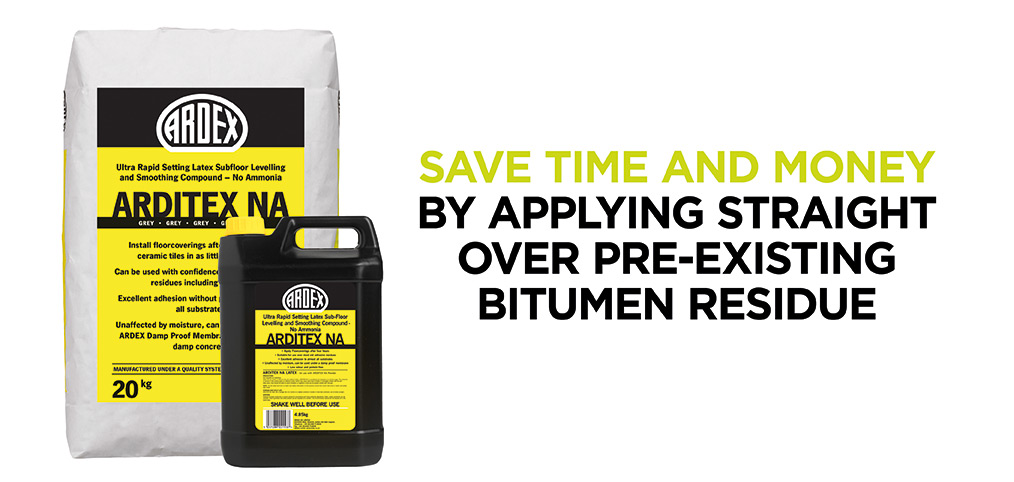5 Common Screed Complexities, Solved

Quite commonly we’re asked for our expert advice on a variety of complexities and problems surrounding screeds. Often it’s a simple case of choosing the right product and application tool combination to solve the problem in the most efficient and effective way. We also find that there are usually multiple ways to achieve the same solution, which is why we pride ourselves on always suggesting the best possible option to save our customers time, money and effort.
#1 - Bitumen residue on the subfloor from old floor covering applications?
This can be a common pain, and it’s fairly labour intensive to remove all traces of bitumen before a levelling compound can be applied, which is what some might suggest doing. However, there is a much simpler solution to this particular problem.
Rick’s Solution:
“Ardex Arditex NA is the ideal product solution as it can be applied over pre-existing bitumen residues, therefore eliminating the need to remove the full bitumen floor covering. It will save you bags of time you might have spent trying to rid the subfloor of bitumen residues.”

#2 - Applying onto a timber substrate?
Unlike many other substrates, timber has a flexible nature, including a tendency to expand and contract depending on temperature and moisture. Therefore, applying directly onto it with the wrong product can be disastrous and result in failure beneath an expensive floorcovering over time.
Rick’s Solution:
“It’s beneficial in this situation that a suitable fibre-reinforced product is used. Ardex FA 20 is the ideal solution and the one we would always recommend, it features Microtec fibres for a durable, flexible and most importantly, a flawless crack-free finish.”

#3 - Need a levelling compound that can support heavy weight on top of the floor covering?
This is often the case in many commercial projects (and some domestic). If you know there is going to be heavy weight loads placed on top of the floor covering you need to plan accordingly. Hospitals and gyms are two common examples that require extra planning to account for weight above.
Rick’s Solution:
“A levelling compound with a high compressive strength is critical to ensure a long-lasting job that can handle the extra weight load. Marldon MXS110 has an impressive compressive strength of 22N/mm2 after 1 day 36N/mm2 when fully cured after 28 days. It’s more than capable of holding a great deal of weight if required.”

#4 - Project requires a smoothing compound that is to be placed beneath a liquid damp proof membrane?
If you’re applying a smoothing compound to be placed underneath a liquid damp proof membrane there’s a risk it could fail if the product used isn’t able to deal with the high levels of moisture that will be present beneath the damp proof membrane.
Rick’s Solution:
“The most important thing is to ensure that a moisture tolerant product is used to ensure it can withstand a high level of moisture without risk of failure. Again, I would recommend Ardex Arditex NA as it’s highly moisture tolerant and an ideal solution in this situation.”
#5 - Applying a smoothing compound directly to a non-porous surface? (glazed ceramic tiles, liquid damp proof membranes etc)
If possible, try to avoid direct application. Take a step back and give your project the best possible head start by first using primer on the non-porous surface. Applying to a non-porous surface can be really problematic as it can result in adhesion issues. The use of a primer beforehand will aid adhesion between the two surfaces and produce an optimal finish.
Rick’s Solution:
“ It is always worth the investment in time and money to use a specialist primer when applying on to non-porous surfaces. Cleaning and de-greasing of the surface are important also. This removes all contaminants and prepares the surface for the application of the smoothing compound. Referring to the manufacturer's instructions is always worth doing to ensure all products are compatible with the surface you are working with.”
Finally, as a bonus, what are the best application tools?
Ensuring you have the right application tools is equally as important! There’s a wide range of tools suitable for screed application, here are some of the most popular and best quality that Havwoods Accessories has to offer:
ITOOLSTIR – Itool stirring station.
FTROWEL – Finishing Trowel
STROWEL – Spreader trowel
SROLLER25 – Spiked aerator roller 250mm
ILP – Itool level pins
STK60 – Itools upright trowel kits – 60cm kit
For more information and advice on a wide range of flooring topics, contact our dedicated technical team on 01772 696600 or email rick@havwoodsaccessories.com

